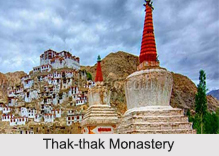 Thak-Thak Monastery also known as Takthok or Thag Thog Monastery is located in the Sakti village of Ladakh region in Jammu and Kashmir. The Gompa is almost 46 km away from Leh district. This Monastery was founded in the reign of Tshe-wang Namgyal in the second half of the 16th century around one of the many caves where the Indian sage Padmasambhava is said to have stayed and meditated during his journey to Tibet. This monastery is the sole representative of the Nying-ma-pa in Ladakh and the oldest of the Tibetan monastic sects. The name of the monastery means "rock roof" because the walls and the roof of the gompa are made out of rocks. Around 55 lamas live in the monastery.
Thak-Thak Monastery also known as Takthok or Thag Thog Monastery is located in the Sakti village of Ladakh region in Jammu and Kashmir. The Gompa is almost 46 km away from Leh district. This Monastery was founded in the reign of Tshe-wang Namgyal in the second half of the 16th century around one of the many caves where the Indian sage Padmasambhava is said to have stayed and meditated during his journey to Tibet. This monastery is the sole representative of the Nying-ma-pa in Ladakh and the oldest of the Tibetan monastic sects. The name of the monastery means "rock roof" because the walls and the roof of the gompa are made out of rocks. Around 55 lamas live in the monastery.
Structure of Thak-Thak Monastery
The Thak-thak Monastery of Ladakh was constructed against the mountainside around Padmasambhava`s cave; the cave had been reformed into the monastery. The main temple of the monastery is excessively dark and gloomy because of the residue of butter lamps that cover the rock ceiling. The smoke of the butter lamps completely obscured the paintings that once adorned the walls. Another cave, which is a little further down, has been turned into a kitchen, where food is prepared for the pilgrims who flock to the gompa`s annual festival. The verandah of the Dukhang has the usual paintings of the Four Lords, while the walls of the temple itself are covered with recent paintings of fierce divinities. A throne inside the assembly hall is reserved for the Dalai Lama.
Tourist Attractions of Thak-Thak Monastery
There are several attractions inside the Thak-thak Monastery, which first includes exploring the cave. Along with that, the library inside the gompa also holds some special significance. It houses almost 108 volumes from the teachings of Buddha, which are called Kanjur. There is also a new temple that was dedicated during 1980 by the 14th Dalai Lama. Apart from that, the mural on Padmasambhava and the painting of Sakyamuni also belong from the special attractions of this monastery. There is also a cave chapel, which is very popular along with another small cave, which is believed to be the location where Padmasambhava resided and meditated for 3 years. Monastery"s annual festival and other festivals of this region attract most of the tourists to this place. Along with the attractions of the monastery, this place is also quite popular for trekking around the mountains.
Visiting Information to Thak-Thak Monastery
The best time to visit this place is during the summer season. Most of the festivals take place in summer season, where sacred dances and rituals can be seen and one can get a glimpse of the culture and tradition of this place. Monsoon season should be avoided because of the rains. As the gompa is 46 km away from Leh district, so the convenient way to reach the monastery is via Leh. Leh can be reached by air, train and road- Leh Airport for flight, Kalka railway station for train and well connected bus routes are for road transport. From Leh, the monastery can be reached by road in any vehicle.



















